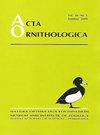基于样线调查和多协变量距离抽样的2011 - 2016年英格兰中南部红鸢Milvus Milvus种群变化
IF 1.3
4区 生物学
Q3 ORNITHOLOGY
引用次数: 3
摘要
摘要成功的重新引入计划通常是指在一段时间后新人口的规模和范围的增加。在鸟类研究中,这些种群估计通常集中在对筑巢尝试和生产力的监测上。然而,对于许多猛禽来说,这种方法可能会忽视大量未繁殖的成年和未成熟鸟类,从而低估种群规模和繁殖潜力。更彻底的方法是对总人口规模进行评估。在这项研究中,我们使用样线调查方法和多重协变量距离采样来评估英格兰中南部2600平方公里地区重新引入的猛禽物种红鸢麋鹿种群规模的变化。调查于2011年至2016年春季和秋季在25年前开始的最初的英语重新引入项目以南45公里的地区进行。调查路线尽可能避免使用道路,以应对此类景观可能具有的潜在吸引力(例如增加食物供应、栖息处等)。在某些情况下,使用道路是不可避免的;然而,当我们将道路沿线的观测距离与5000个随机生成的位置进行比较时,没有发现红鸢对这些景观特征有吸引力的证据。探测距离受鸟类活动(当鸟类在地面上或与其他鸟类互动时最大)和林地范围的影响,但不受一天中的时间、季节性或年份比较的影响。在这五年中,估计人口规模翻了一番,从大约490人增加到1100人;密度为每2.5–3.5平方公里一只红鸢。这表明研究区域的繁殖种群从大约95对增加到174对。在研究期间,人口增长率并不一致;在研究的第二年和第三年出现了快速增长,随后在最后两年出现了放缓。尽管英格兰东南部种群的总体增加和合适的筑巢栖息地的可用性表明红鸢繁殖种群仍有扩大的潜力,但其他因素可能会限制这种增长。本文章由计算机程序翻译,如有差异,请以英文原文为准。
Population Change of Red Kites Milvus milvus in Central Southern England between 2011 and 2016 Derived from Line Transect Surveys and Multiple Covariate Distance Sampling
Abstract. Successful reintroduction programmes are usually defined by an increase in size and extent of the new population after a given period of time. Among studies of birds, these population estimates are often focused on the monitoring of nesting attempts and productivity. For many raptors, however, this approach can overlook a large number of non-breeding adults and immature birds leading to underestimation of population size and reproductive potential. A more thorough approach is to generate assessments of total population size. In this study we used a line transect survey methodology and multiple covariate distance sampling to assess the change in population size of a reintroduced raptor species, Red Kite Milvus milvus, across a 2600 km2 area of central southern England. Surveys were performed in spring and autumn between 2011 and 2016 in an area 45 km to the south of the initial English reintroduction project which started 25 years previously. Survey routes avoided using roads where possible to counter the potential attraction that such landscape features may have (e.g. increased food availability, perches etc.). The use of roads was unavoidable in some instances; however, we found no evidence of Red Kite attraction to these landscape features when comparing distances of observations from stretches along roads with 5000 randomly-generated locations. Distance of detection was influenced by bird activity (greatest when the bird was on the ground or interacting with other birds) and extent of woodland but not by time of day, seasonality or when comparing between years. During the five years, estimated population size doubled from approximately 490 to 1100 individuals; a density of one Red Kite per 2.5–3.5 km2. This suggests an increase in the breeding population in the study area from c. 95 to 174 pairs. During the study, rate of population growth was not uniform; rapid growth was recorded in years two and three followed by a slowing over the last two years of the study. While an overall increase in population and availability of suitable nesting habitat across south-eastern England indicates that there is still potential for expansion of the Red Kite breeding population, other factors are potentially limiting this growth.
求助全文
通过发布文献求助,成功后即可免费获取论文全文。
去求助
来源期刊

Acta Ornithologica
生物-鸟类学
CiteScore
2.10
自引率
0.00%
发文量
14
审稿时长
>12 weeks
期刊介绍:
Publishes scientific papers (original research reports, reviews, short notes, etc.) and announcements from all fields of ornithology. All manuscripts are peer-reviewed.
Established in 1933 as Acta Ornithologica Musei Zoologici Polonici, since 1953 continued under the present title.
Published twice a year by the Natura Optima Dux Foundation under the auspices of the Museum and Institute of Zoology, Polish Academy of Sciences.
 求助内容:
求助内容: 应助结果提醒方式:
应助结果提醒方式:


